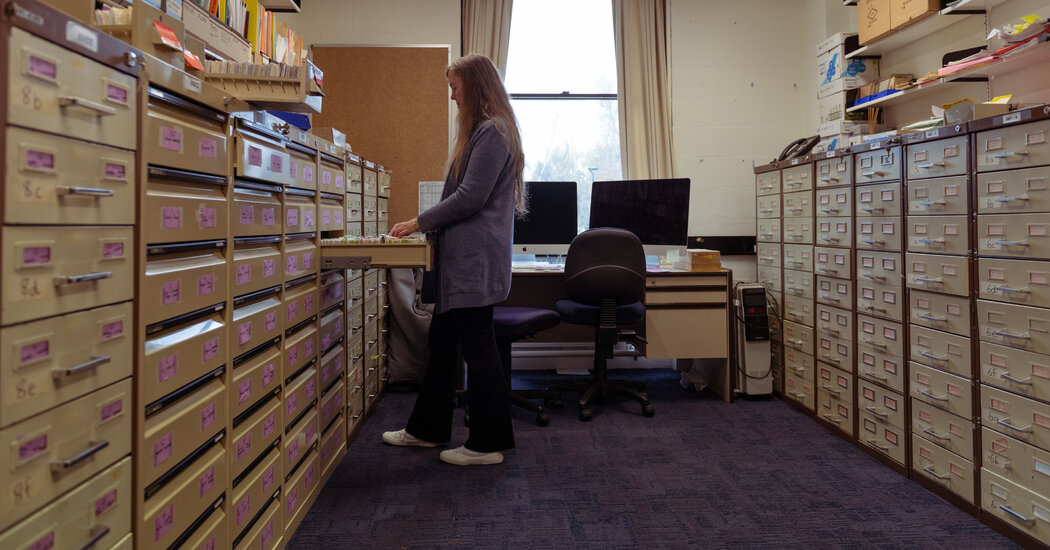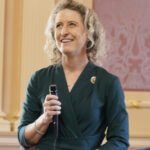
CANBERRA, Australia — Amanda Laugesen scrolled through the spreadsheet of 7,000 words and idioms being considered for the next edition of the Australian National Dictionary, but no matter how hard she looked, she just couldn’t find the phrase.
“Few bricks short of a pallet” was there. So was “face like a bucket of smashed crabs.”
But where was “face like a half-sucked mango?”
Spinning quickly from the screen, she got up and walked down the hall to ask Mark Gwynn. They’d been working together at the Australian National Dictionary Center in Canberra for more than a decade, and they had both seen phrases go missing in drafts of what a colleague had called their “herbarium of words.”
Mr. Gwynn, a former poetry student, was also stumped by the disappearance. “Well, we know we’ve got ‘face like a twisted sand shoe,’” he said, recalling similar entries in their database. “It’s not under ‘mango’ or ‘sucked’?”
Dr. Laugesen shook her head. The author of a book about Australia’s penchant for off-color language, with a Ph.D in American history, she looked almost as mad as a cut snake.
“This is the problem,” she said, lamenting the lost mango insult. “Sometimes you get stuck.”
Clearly, updating a dictionary of Australian English on a shoestring budget is a special kind of hard work — or “hard yakka,” for those who speak the local language. The Australian National Dictionary includes only words and phrases that have originated in Australia, that have a greater currency in the country, or that have a special significance in Australian history. And the process is a bit like panning for gold.
Sometimes the job requires sifting through the muck of politics, collecting Australianized phrases like “loose unit,” which is how Prime Minister Scott Morrison described Anthony Albanese, the eventual victor in last month’s national election, after Mr. Albanese made an economic proposal.
Sometimes it means scanning Twitter or reading memoir after memoir, looking for phrases that have become more valuable among Indigenous Australians, like “story custodian,” or new communities of Australians — like “ABC,” for Australian-born Chinese.
It can also mean paying close attention to how words change. Australians have a long history of turning some abbreviations or seemingly innocuous phrases into slurs, based on race, gender or country of origin. And they also tend to shine up, or “ameliorate,” others, taking “bloody” or “bastard” and making them part of the more commonly accepted vernacular, often long before Britain.
All of this work, the forensics of national dictionary research, is relatively new in Australia.
The Oxford English Dictionary emerged gradually from 1884 to 1928. Noah Webster published “An American Dictionary of the English Language” in 1828. But the first serious look at the Australian language, by Sidney Baker, a New Zealander, came out in 1945. And the first edition of the Australian National Dictionary — a partnership between the Oxford English Dictionary and the Australian National University — hit libraries only in 1988.
The delay reflected what the dictionary itself sought to fix, an accepted disrespect from inside the country and beyond for how Australians talked. It took Australians themselves a long time to recognize that the way they spoke and wrote reflected a unique place and culture, more than just a distant colony thought to be butchering the Queen’s English.
Bruce Moore, a former medieval English scholar who was the director of the National Dictionary Center from 1994 to 2011, noted that a lot of words and sayings that captured “Australian qualities” were looked down upon among educated elites.
Words like “battler” (a person who works doggedly and with little reward) or the admonition to never “dob in your mates” (inform on your friends) or “rort the system” (cheat or engage in fraud) were all there in Australian English, “but they were not recognized in the traditional ‘public square,’” Dr. Moore said. “It’s only the 1970s when these terms come into the forefront of Australian English and are recognized and people start, for a change, being proud of the fact that this was their language.”
The first edition of the dictionary had 10,000 entries. The second, which came out in 2016, held 16,000, including words borrowed from more than 100 Indigenous Australian languages — billabong, kangaroo and yabby, to name a few.
Most of the entries started out on handwritten index cards, with citations to where the earliest use could be found.
It was the same process employed for the original Oxford English Dictionary, and it means that there is a tangible archive. At the Australian Dictionary Center, which sits inside a musty humanities building on the campus of the Australian National University, photos of O.E.D. editors with long beards stand near wide, squat filing cabinets with cards containing Australian phrases included and discarded.
Open a drawer, catch the ruddy smell of dry rubber bands breaking free from stacks of old paper, and you might find a rough gem that never made it in and might be lost forever, like “beero” or “Antonio de Fat Pizza,” which appeared to be linked to a television show in 2003.
Also among the rejects is “selfie,” the one word that Dr. Moore still finds himself mulling over. He said he knew that the Oxford English Dictionary had found the earliest evidence for the word in an Australian newsgroup online, but within weeks, selfie was everywhere.
“I asked myself, ‘Is there enough proof to say ‘that’s an Australian invention’?” he said. “And I thought, I’m not convinced. And then as soon as the dictionary came out, I thought bugger it. I’m going to be known for this moral failing.”
Even now, selfie’s origins are unresolved. Dr. Laugesen is also not convinced that Australia deserves the credit or blame.
The phrases she can’t stop thinking about now are the ones that might reflect Australia’s growing ambivalence — or self-deprecating sense of humor — about the country’s gentrified taste after a long run of mining- and real-estate-driven economic growth.
Some people, for example, are said to be part of the “goat’s cheese set” or to live “behind the quinoa curtain” or the “latte line.” Dr. Laugesen said it was hard to tell if the early citations would point to a grass-roots critique or a more politicized campaign. But the trend seemed to be connected to the evolution of another extremely Australian word — “bogan.”
In the 1980s, it referred to “a boorish and uncouth person,” typically from Sydney’s working-class western suburbs. Now it seems to be used as a badge of honor. Dr. Laugesen noted that “fauxgan,” or fake bogan, was becoming the bigger insult, while finding your “inner bogan” was an honorable goal, suggesting Australians were eager to reclaim their more unsophisticated past.
Even that half-sucked mango spoke to the theme, as became clear when Dr. Laugesen solved the mystery of its disappearance. Eventually, she found it in the “H” words, noting that there was evidence for three iterations: “head like a half-sucked mango; face like a half-sucked mango” and “hair like a half-sucked mango.”
At least one of those appeared in a memoir by Nick Cummins, a former professional rugby player, nicknamed “the Honey Badger,” who rose to prominence after starring on the sixth season of Australia’s version of “The Bachelor.” His mop of unruly hair seemed to be a source, but it was far from the only reference Dr. Laugesen found.
“I’m not sure how we’ll organize these kinds of idioms at this stage, especially the head, face being somewhat interchangeable,” she said.
Like “latte line,” the phrase seemed destined for inclusion in next year’s new online edition.
“It needs to tell some kind of story about Australia,” Dr. Laugesen said. “The story might not be totally evident from the entry, but it has to be there.”



